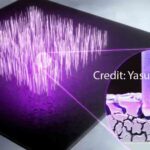Revolutionizing the Power Grid with Superconducting Transmission Lines
superconducting transmission lines power grid
VEIR, an innovative startup founded by MIT alumnus Tim Heidel, has pioneered a breakthrough in power transmission technology, allowing for significantly higher energy transfer over long distances, without the need for expanded infrastructure.
The company introduced its cutting-edge power transmission line in Woburn, Massachusetts, capable of handling up to ten times more power than conventional lines.
This remarkable innovation offers a potential solution to the grid capacity challenges essential for supporting renewable energy integration and fortifying grid resilience.

Revolutionizing Power Transmission
In Woburn, Massachusetts, last year, a seemingly ordinary power line was installed over a 100-foot stretch of land. To a casual observer, nothing appeared out of the ordinary.
The line was suspended on regular utility poles, a sight familiar to anyone who has driven past them countless times. However, this very unassuming nature of the installation underscores the promise of VEIR’s technology.
These lines are engineered to transport five to ten times the power of traditional transmission systems, all while utilizing the same footprint and voltage level.
This characteristic is instrumental in bypassing the regulatory and community challenges that typically hinder grid expansion, especially in regions such as the U.S. and Europe, where new energy infrastructure is critical for transitioning to renewable sources and enhancing grid durability.
Years of rigorous development at VEIR, co-founded by Tim Heidel, led to the creation of these lines. They utilize superconducting cables and a proprietary cooling mechanism, enabling initial power transmission of up to 400 megawatts, with future versions potentially achieving several gigawatts.
“We’re able to deploy far higher power levels at much lower voltage, which allows us to maintain the same footprint while dramatically reducing visual impact. This innovation helps us overcome many of the public and regulatory hurdles typically associated with transmission projects,” explains Heidel.
Meeting the U.S. Energy Demand
VEIR’s technology arrives at a pivotal moment. Over 10,000 renewable energy projects are in various stages of development, waiting for approval to connect to U.S. grids. According to the White House, the U.S. must more than double its regional transmission capacity to meet the 2035 decarbonization goals.
Electricity demand is surging due to the proliferation of data centers, artificial intelligence, and the electrification of vehicles and heating systems, further stressing existing infrastructure.

Transmission Infrastructure Challenges
Despite these trends, constructing high-power transmission lines remains an arduous task.
“Building such infrastructure can take a decade or more, with numerous examples of abandoned projects due to insurmountable opposition or excessive complexity that drives up costs,” says Heidel. “We’re able to lower the voltage while maintaining the same power levels, allowing our lines to blend into the background and sidestep much of the usual resistance.”
VEIR has garnered significant interest from utilities, data center operators, industrial companies, and renewable energy developers, aiming to complete its first commercial-scale high-power pilot by 2026.
Heidel’s Path in Energy
Tim Heidel’s academic journey at MIT, spanning over a decade, transitioned from mastering electrical engineering fundamentals to studying the broader power grid sector. His educational path culminated in a bachelor’s, master’s, and PhD from MIT’s Electrical Engineering and Computer Science department, along with a master’s from MIT’s Technology and Policy Program, completed while pursuing his PhD.
“I became deeply focused on energy and climate during my graduate studies,” Heidel reflects.
Shaping the Future of Power Transmission
After completing his PhD, Heidel became the research director for MIT’s “Future of the Electric Grid” study in 2011.
“That opportunity was a foundational moment early in my career. It provided a holistic view of the grid’s challenges, the power sector’s landscape, and insights into the future trajectory of the electric grid,” says Heidel.
Following his time at MIT, Heidel joined the Department of Energy’s Advanced Research Projects Agency-Energy (ARPA-E) and later, Bill Gates’ Breakthrough Energy Ventures (BEV), where he continued his research on transmission.
“Virtually every decarbonization scenario over the past two decades concludes that doubling or tripling the scale of power grids is essential to achieve emissions reductions. However, when we analyzed the data on grid expansion rates, transmission costs, and construction times, nearly all indicators were trending negatively. Transmission was becoming more costly and time-consuming. We urgently needed a transformative solution.”
VEIR’s Cooling System
A Game-Changer in Transmission Unlike traditional steel and aluminum transmission lines, VEIR’s technology capitalizes on decades of advancements in high-temperature superconducting materials. Some of these developments were spurred by the nuclear fusion industry, which uses superconducting materials in reactor designs.
The real breakthrough at VEIR, however, lies in its cooling system. Steve Ashworth, VEIR co-founder and advisor, initially conceived the cooling concept over 15 years ago at Los Alamos National Laboratory. The idea remained dormant until it was revived by Heidel and his team at Breakthrough Energy Ventures in 2019.
Today, VEIR’s system is passively cooled using nitrogen that flows through a vacuum-insulated pipe surrounding the superconducting cable, with heat exchange units installed on select transmission towers. This design enables far smaller transmission lines compared to traditional systems, which typically require much larger structures for equivalent power levels.
“High-power lines generally require high voltage, and high voltage demands tall towers and wide clearances—both of which face widespread opposition,” Heidel explains. “This holds true across the globe.”
Global Impacts and Future Expansion
VEIR’s initial alternating current (AC) overhead transmission lines can carry up to 400 megawatts of power at voltages up to 69 kilovolts, with future plans to develop higher-power direct current (DC) lines. The company intends to supply its equipment primarily to U.S. transmission projects.
In the long term, Heidel believes VEIR’s innovations are critical for meeting rising electricity demands and facilitating renewable energy projects worldwide.







